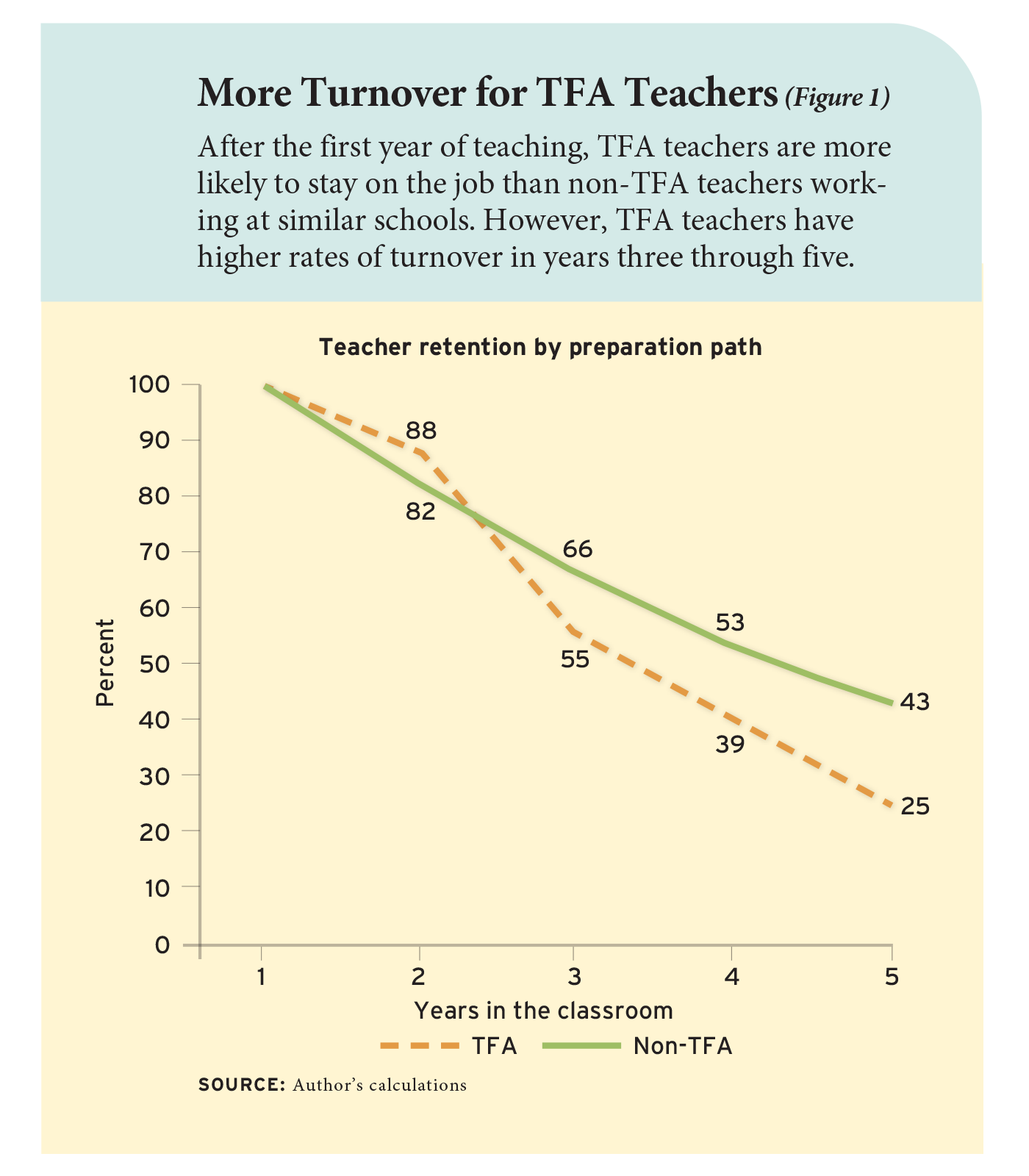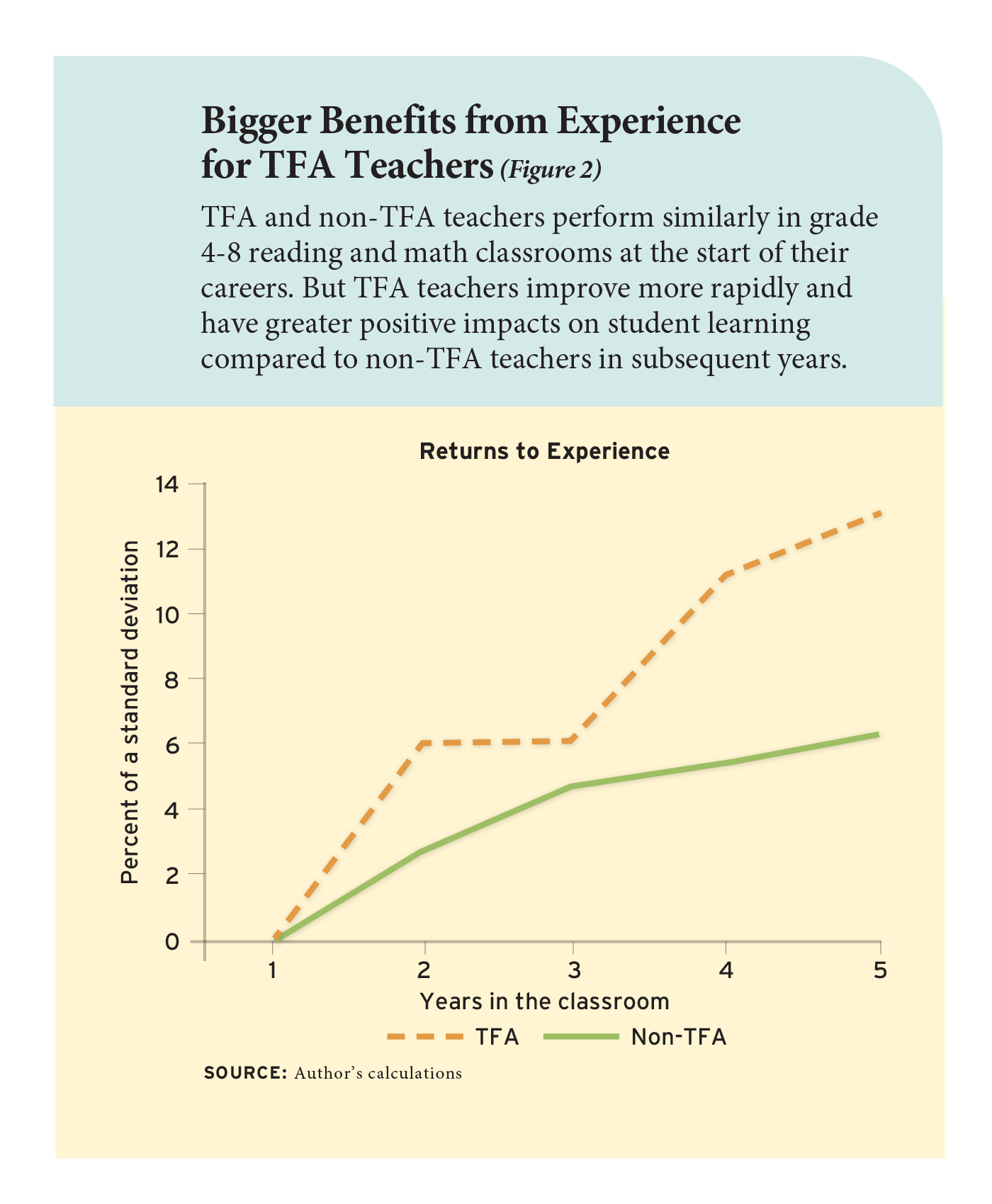
Since its founding 34 years ago, Teach For America has prepared nearly 70,000 recent college graduates and career-changers to teach in high-poverty schools across the United States. The selective program recruits mission-driven applicants, with annual admissions rates as low as 12 percent. Unlike traditional teacher-preparation programs, it places “corps members” in short-staffed public schools after an intensive summer seminar, before they are fully certified to teach, and provides additional support and training during a two-year stint in the classroom.
The program, which is part of Americorps and known broadly as TFA, has been both successful and controversial. Its theory of action is that bringing highly educated, mission-motivated “future leaders” into public schools in low-income communities will positively impact student learning, influence professionals to commit themselves to the issue of educational equity, and give educational equity a firmer foothold in the nation’s agenda. Prior research has found encouraging evidence on all counts. TFA teachers perform as well or better than their most likely alternative during their first two years in the classroom, and compelling quasi-experimental evidence suggests participating in TFA shapes alumni’s worldviews. As one example, TFA participants are more likely to view student achievement gaps as a symptom of systemic social injustices rather than a symptom of individual choices or behaviors (see “How Teach For America Affects Beliefs About Education,” research, Winter 2020). In addition, TFA alumni are well represented in state departments of education and have founded some of the nation’s largest charter-school networks (see “Creating a Core of Change Agents,” feature, Summer 2011).
The program remains controversial, however. TFA teachers are usually new to education, and critics worry that the program provides students who arguably have the greatest need for excellent instruction with the least-prepared novice teachers. In addition, TFA teachers commit to just two years in the classroom. In general, teachers improve rapidly during their first five years, which means that TFA teachers are scheduled to move on before they fully get the hang of the job.
These concerns, and the evidence base to date, overlook TFA teachers who continue teaching for five years or more. To learn how these teachers perform over the longer term, I look at estimates of value-added, or the estimated contribution to students’ test scores, of TFA teachers in New York City between 2012 and 2019, when about 25 percent remained teaching after year five. I compare that to the same estimates of non-TFA teachers working in TFA-participating schools, 43 percent of whom taught for at least five years.
TFA alumni who choose to keep teaching improve more rapidly over the first five years of their career than non-TFA teachers. The average TFA teacher who stays in the classroom for five years or more improves at more than double the rate of non-TFA teachers, at 13 percent of a standard deviation by year six compared to 6.3 percent of a standard deviation.
I then explore the question of whether regular turnover within the TFA workforce neutralizes or offsets these effects. To examine this issue, I compare student performance under two hypothetical scenarios: a district policy to continually hire TFA teachers to replace exiting corps members, or a district policy to never hire any TFA teachers at all. My results show a district policy of continuous TFA hiring would boost student achievement by an estimated 5 percent of a standard deviation relative to a policy of no TFA hiring. So long as exiting TFA teachers are replaced by new TFA recruits, student achievement will be higher, on average, than if the district did not hire any TFA corps members.
To be clear, hiring is complex, and teachers’ projected effects on student achievement should not be the only criterion driving staffing decisions. This research addresses a singular concern—that high turnover among TFA teachers drives down student achievement over the long run. Overall, I find that the data does not substantiate this concern, given the rapid rate at which TFA teachers improve on the job.
Assessing an Alternative Teacher Pipeline
TFA was launched in 1990 and rooted in founder Wendy Kopp’s undergraduate senior thesis at Princeton University. The thesis called for the creation of a new public-service program to train college seniors who did not major in education to teach in high-poverty schools for two years, building on a wave of new alternative-route certification laws that had been adopted in 20 states. From TFA’s earliest cohort of 489 recruits, the non-profit has expanded to 50 cities and regions nationwide. Over that same time, the share of U.S. teachers trained through alternative-certification programs has grown to nearly one in five. By 2023, every state except Alaska, Oregon, and Wyoming had adopted an alternative-route certification law.
Kopp was inspired by the recruiters from investment banks and consulting firms, who aggressively scouted talent and offered promising students an impressive launching pad after graduation. TFA recruiters used a similar approach, and the program quickly became a sought-after post-collegiate option; in 2011, fully 18 percent of Harvard’s graduating class applied. The competitive nature of the short-term program and demographics of its idealistic, highly educated corps members, who were predominantly wealthy and white at that time, attracted skepticism and critiques. Over the last decade, the organization has shifted its recruitment and training practices to achieve a more diverse corps of educators whose background or ethnicity matches that of their students. Today, about 60 percent of TFA corps members are Black, Indigenous, or people of color, compared to 20 percent of all U.S. teachers. In addition, 45 percent of TFA corps members are first-generation college graduates.
Another important change is the growing number of TFA alumni who have continued to work in the classroom—nearly one in four, or 14,600 teachers nationwide. To fully understand the impact of TFA on student learning, we need to assess the performance of these alumni over the longer term.
The New York City Department of Education, the nation’s largest school district, has hired nearly 6,000 TFA corps members since 1990. My analysis is based on New York City public schools that hired both TFA and non-TFA teachers between 2012–13 and 2018–19. These schools tend to have relatively lower standardized test scores, greater shares of students of color, and more students from low-income families. On average, student performance is 36 percent of a standard deviation below the citywide mean.
The data include teacher salary data, which I use to identify teachers’ years of experience. Because the district does not maintain the same data for charter-school teachers, those teaching at charters are excluded from this analysis. I further restrict the sample to teachers working in grades and subjects participating in state tests: grades 4 through 8 in math and English Language Arts. In all, my analysis includes 308 TFA teachers and approximately 40,000 non-TFA teachers.
I first look at retention rates. Overall, first-year TFA teachers are more likely than non-TFA teachers working in similar schools to keep teaching a second year, but less likely to remain in the classroom by year five (see Figure 1). About 88 percent of first-year TFA teachers persist to a second year compared to 82 percent of non-TFA teachers. However, non-TFA teachers are retained at higher rates in years three and beyond. Over the study period, 43 percent of non-TFA teachers kept teaching for five years or more, compared to 25 percent of TFA teachers.

Impacts on Student Performance
To estimate returns to experience for TFA and non-TFA teachers, I use a measure of value-added, or how much their students improve on annual tests in math and reading relative to expectations based on the students’ prior achievement and demographic characteristics. My calculations control for teacher and student characteristics and assume a “steady state” of the world, with no major changes in overall teacher supply or average teacher performance over time.
First, I look at teachers’ initial performance and find no average difference in first-year performance for TFA and non-TFA teachers. Then I look at teacher value-added by years of experience. Over the first five years of their careers, TFA teachers improve by 13 percent of a standard deviation compared to 6.3 percent for non-TFA teachers (see Figure 2). In particular, between their first and second year in the classroom, TFA teachers improve by 6.1 percent of a standard deviation, more than twice the rate of non-TFA teachers at 2.8 percent of a standard deviation. Non-TFA teachers catch up somewhat in year three, but TFA teachers continue to improve more quickly in the subsequent early-career years.
What do these results imply regarding the effects of TFA hiring on the teaching workforce over time? Because of their higher turnover rates, TFA teachers are about 1.5 times more likely to be in their first year of teaching than non-TFA teachers and only half as likely to have five years of experience or more. Nevertheless, I find that hiring continually hiring TFA teachers to replace exiting corps members, as compared to hiring non-TFA teachers, would increase student achievement by an estimated 5 percent of a standard deviation. This estimate assumes a constant turnover rate after year five and, consistent with my findings, assumes no average difference in performance for TFA and non-TFA teachers in year one.
This analysis may well understate the advantages for schools of relying on TFA. Given the staffing challenges common at schools that hire from the program, it could be the case that the best alternative to a TFA teacher is not the average first-year traditionally trained teacher, but rather a long-term substitute or a college graduate with an emergency certification who may or may not have any training in education or in the subject they teach. In that case, TFA teachers could perform better in year one than these likely alternatives and the estimates reported here would understate the true benefits of TFA hiring for student achievement.

Changing Demographics
While prior research has shown that TFA teachers perform as well or better than their most-likely alternative during their first two years in the classroom, my analysis additionally suggests that TFA teachers who continue teaching beyond year two continue to outperform their non-TFA counterparts after five years in the classroom.
This is a somewhat different result than that of a 2007 study of TFA teachers in New York City, which did not find meaningful differences in performance between teachers based on their certification status or preparation path. It also showed TFA teachers underperforming traditionally certified teachers in their first year before quickly catching up (see “Photo Finish,” research, Winter 2007). I find no difference between TFA and non-TFA teachers in year one, and faster performance gains for TFA teachers in years two through five. What could account for this difference?
One plausible explanation could be changes in TFA’s recruiting, workforce, and organizational strategy from its earliest days. These evolved dramatically between the two study periods to include an explicit focus on corps-member diversity. The TFA teacher workforce of the late 1990s and early 2000s skewed young, wealthy, and white; in New York City, TFA teachers were 82 percent white, and the median age was 23. By contrast, as of 2014, one-third of TFA teachers identified as first-generation college graduates, one-half as teachers of color, and 43 percent as growing up with a low household income. Research points to this increase in representation and instruction by teachers with backgrounds similar to their students as a powerful learning accelerator for students of color (see “What We Know About Teacher Race and Student Outcomes,” feature, Winter 2024).
TFA and other alternative-certification programs have grown rapidly over the past three decades. There are now more than 200 alternative providers, which prepare about one in five newly hired U.S. public-school teachers. While these teachers have higher rates of turnover after they are hired, they also are dramatically more racially diverse than teachers trained in traditional college-based programs. A review by the Center for American Progress found that in 2018–19, aspiring Black and Latino teachers accounted for 37 percent of all graduates of alternative-route programs based outside universities, compared to 17 percent at traditional teacher-preparation degree programs.
TFA, though a smaller provider, has influenced the national conversation about who should teach American students and how best to prepare those recruits. After several years of shrinking its workforce, the organization grew its corps members by 40 percent this year and is planning to grow by another 25 percent next year, with “an exceptional and diverse cohort” of 2,000 new teachers nationwide. A ripe area for future research is to examine whether improvements in the performance of the TFA workforce since the early 2000s continue and if they are a direct result of the organization’s efforts to recruit teachers who more closely resemble the students they serve.
Virginia S. Lovison is an Associate Director of Research & Policy at Deloitte Access Economics and a former postdoctoral research associate at the Annenberg Institute for School Reform at Brown University. This analysis is the author’s own, independent of Deloitte Access Economics.
This article appeared in the Spring 2024 issue of Education Next. Suggested citation format:
Lovison, V.S. (2024). Teach For America’s Fast Path to the Classroom Accelerates Performance Over the Longer Haul. Education Next, 24(2), 46-51.
For more, please see “The Top 20 Education Next Articles of 2024.”


